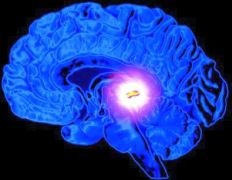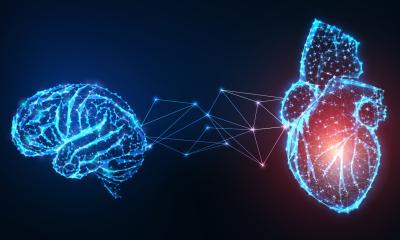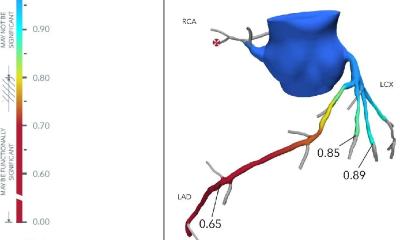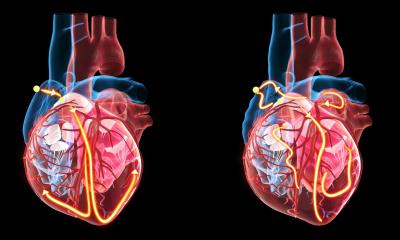Right light lifts fatigue and concentration
Study demonstrates the psychological effects of good illumination.
Melatonin hormone controls the circadian rhythm. In periods of darkness, melatonin reduces cardiovascular activity and induces fatigue. Morning light inhibits melatonin secretion in the pineal gland, which increases cardiovascular activity.

Melatonin inhibition peaks at 450 nm in the continuous visual spectrum, i.e. in the blue spectral range. Light containing a large proportion of blue wavelengths therefore inhibits the secretion of melatonin in the pineal gland. If these blue wavelengths are absent (reddish light), melatonin secretion is uninhibited, which produces fatigue.
Recent research, led by Professor Dietrich Gall, head of the Lighting Technology Department, at Ilmenau University of Technology, Germany, with the cooperation of the lighting firm Berchtold GmbH & Co. KG, of Tuttlingen, analysed lighting as a form of radiation, which therefore the question of the potential psychological effects of its dose level on surgeons.
In 2002, Professor Gall succeeded in describing the circadian effect of light in mathematical terms, defining the circadian effect coefficient (acv coefficient) as the ratio between the visual utilisation effect (taking the photoreceptors’ effect curve into account) and the circadian utilisation effect (taking the effect curve of the circadian retinal receptors into account). So it became possible to measure the circadian effect of light, and provide a simple means to describe the physiological effect of light. Volker Dockhorn, engineer and Product Manager, OR-Lights, Berchtold, explained that the goal was to determine whether surgical lights of different colour temperatures produced different physiological effects on a surgeon, and use that knowledge to deliberately reduce fatigue and improve their wakefulness when working at night.
Chromophare X 65:
Tn: 4300 K - acv undimmed: 0.60 - acv dimmed: 0.60 - remark: optomechanical dimming
Chromophare D 650 plus
Tn: 4300 K - acv undimmed: 0.59 - acv dimmed: 0.51 - remark: electronic dimming
Comparative light :
Tn: 3400 K - acv undimmed: 0.45 - acv dimmed: 0.38 - remark: electronic dimming
Table 1: Results of measurements of the circadian effect coefficient for three surgical lights. All lights were first measured at an luminance of 100,000 lux and subsequently with luminance dimmed to 50%
Table 1 presents results of measurements of the circadian effect coefficient (acv coefficient) for three surgical lights, one gas discharge light (Berchtold Chromophare X 65), one halogen light with a high colour temperature of 4,300K (Berchtold Chromophare D 650plus) and one halogen light of comparable size, from another firm, with a lower colour temperature of 3,400K and a large red component. All lights were first measured at a luminance of 100,000 lux and subsequently with luminance dimmed to 50%.
The table shows that the gas discharge light achieved the highest circadian effect coefficient, followed closely by the halogen light with high colour temperature. By comparison, the surgical light with low colour temperature showed a poorer performance, achieving a circadian effect coefficient approx. 25% below that of the halogen light with high colour temperature. Dimming the three lights during operation gives a different outcome. The only light to maintain its high stimulating effect when operated at reduced luminance is the gas discharge light with optomechanical dimming. By contrast, electronic dimming of the halogen lights results in an altered colour spectrum, impairing the physiological effect of these two lights.
The results described would suggest that the gas discharge light Chromophare X 65 and the halogen light Chromophare D 650plus, with its high colour temperature (4,300K), cause less fatigue, whereas it would be expected that surgery performed under a halogen light with a lower colour temperature (3,400K) would cause greater fatigue, especially at night.
To verify this outcome, the study examined the performance and concentration of 55 participants. In one group, 30 people carried out tests in winter; in the other, 25 performed them in summer, to determine seasonal effects. Experiments were limited to a study of the difference in effect between the two halogen lights, which initially irradiate a similar spectrum. The colour temperature difference between the two lights arises through selective filtering of the wavelength spectrum by light manufacturers.
The irradiated surface was flat, and its reflectivity was therefore higher (76%) than is usually the case with human tissue. For this reason the luminance of both lights was adjusted to 40,000 lux, by altering the size of the light field. The light field diameter was the same for both. The acv value for the halogen light with high colour temperature was 0.59, whilst for the one with lower colour the temperature was 0.45, said Volker Dockhorn.
The participants did not know which lights were being used. To induce a general state of fatigue, such as results through mental work, the participants were asked to solve arithmetical problems under time pressure. Then the d2 test was performed, to determine a subject’s performance capability and power of concentration. The sequence in which the lights were used was altered from one test to the next. 50% of participants began the tests under the light with high colour temperature (Berchtold), then, following an adaptation interval, performed them under the light with lower colour temperature. The remaining 50% began tests under the reference light.
On average, participants working under the Berchtold light answered 502 questions; those working under the reference light answered only 485 questions - equivalent to a 3.5% improvement in performance by those working under the Berchtold light. Statistical error probability was 0.069 in this case, i.e. only slightly short of the significance threshold (0.05), and it is therefore justified to point to a trend.
Winter - If, as a means to determine power of concentration - the number of questions answered correctly is considered, the difference was even more pronounced. On average, under the Berchtold light 205 questions were answered correctly, whereas under the reference light 195 questions were correct - an average, 5.1% lower than in the case of the reference light. The result has an error probability of 0.041, i.e. within the significance threshold of 0.05. Therefore, in winter, a significant increase in power of concentration and a decrease in error frequency were found in work performed under the Berchtold light with a high colour temperature of 4,300K.
Summer - Participants’ performance was practically the same for the two lights, so no difference in exposure effects was found. Learning effects in the course of the test were observable, but were cancelled out in the outcome by altering the order in which lights were used.
‘We eliminated all device-related or test variables that might have influenced the outcome, so as to obtain a meaningful result, free of side-effects,’ said the study director Dr Cornelia Vandahl, an engineer at TU Ilmenau. ‘It was interesting to see such a great difference in outcome between winter and summer tests. Evidently the participants were already fully charged up with light in the summer, whereas in winter people tend to lack light, making an appropriate choice of lighting all the more important.’
The scientists presume that the results would diverge even more if the tests were carried out at night, when melatonin blood levels are higher. However, as it was, even tests carried out during the afternoon or evening showed a clear trend and, in some part, also significant results that appear to confirm the results of the physical measurements.
Thus the study has proved that a high colour temperature of 4,300 - as irradiated by a Chromophare D 650plus light - can enhance a surgeon’s performance capability during the winter (trend). Work performed under a surgical light of low colour temperature (3,400 K) is subject to a significantly greater error frequency. During night surgery, when a surgeon’s melatonin blood level is high, this effect is presumed to be particularly pronounced.
Berchtold is continuing this research, focusing on a larger group of participants.
01.03.2005









